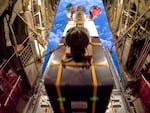
This photo provided by the French Army shows an airdrop over the Gaza Strip on Jan. 4.
AP
The U.S. military on Saturday began dropping food over the Gaza Strip, a war-torn enclave desperate for humanitarian aid.
A U.S. official told NPR that three U.S. C-130 aircraft have begun to provide aid to civilians in Gaza, joining French and Jordanian efforts.
The aircraft dropped 66 bundles of halal meals ready to eat (roughly 40,000 meals) to southwest Gaza, being careful to drop them in an open area away from any crowds, the official said, adding there is "potential for follow-on aid." The official would not say where the planes came from.
President Biden on Friday said the U.S. would carry out airdrops in coming days, "redouble our efforts to open a maritime corridor, and expand deliveries by land."
The collapse in the delivery of humanitarian aid to Gaza has produced gut-wrenching outcomes: Children dying of malnourishment, desperately hungry Palestinians rushing aid trucks to feed their families, and on Thursday morning, scores killed trying to access aid from a convoy going into Gaza City.
Related: Condemnation of Israel’s actions in Gaza grows after dozens killed while seeking aid
The routes to take aid in by land rely on a number of factors, such as border crossings, availability of drivers in Gaza to receive the trucks and drive the supplies where they need to go as well as having clearance from the Israeli military for safe passage.
But the fact that little — or not nearly enough — aid has actually made it into Gaza has prompted several countries to use airdrops to deliver aid. According to the U.N. Office for Coordination of Humanitarian Affairs (OCHA), a quarter of Gaza's roughly 2.2 million people is "one step away from famine."
Access to the Gaza Strip has been severely limited since the start of the war on Oct. 7. That's when Hamas led an attack on Israel, killing 1,200 people and kidnapping 240, according to Israeli officials. The Israeli response has killed at least 30,320 Palestinians, according to Gaza's Health Ministry.
But what factors need to be considered in using airdrops to deliver aid?
Related: Scores killed trying to get food from an aid convoy during a chaotic scene in Gaza
Following Biden's announcement, the International Rescue Committee issued a statement saying that "airdrops do not and cannot substitute for humanitarian access." The group also called for "the safe an unimpeded movement of humanitarian aid" to Gaza.
According to a 2021 report by the World Food Program, airdrops, in addition to costing roughly seven times what ground-delivered aid would cost, can deliver aid in smaller amounts than truck convoys, and require a significant amount of ground coordination in the delivery zone.
For one thing, the drop zones need to be designated and cleared — ideally, they'd be open area, drop zones need to be open areas, no smaller than a soccer field — at least 210 feet by 330 feet.
This is likely why deliveries have been aimed at beaches, but sometimes, as with the airdrops by Egypt, Jordan, the United Arab Emirates, Qatar and France, that results in aid falling into the sea. In the case of another Jordanian effort on Thursday, the wind carried some of the aid over into Israel.
Related: How much humanitarian aid is getting into Gaza? The exact answer can be hard to know
The World Food Program report also highlights the need for coordinators on the ground.
"A team on the ground ensures the drop zone is clear and gives the crew onboard the aircraft the green light to release the cargo. They later coordinate the distribution of the food," it says. There's no evidence of anyone being on the ground to help with this process in Gaza.
Another issue: The type of aid being sent. While no one argues that any aid is better than no aid, a 2016 report written at a time when aid was being airdropped into Syria, the International Committee of the Red Cross points out that control of distribution is needed to ensure that people don't risk their lives from eating the wrong things.
"...delivering sudden and unsupervised types of food to people who are malnourished or even starving can pose serious risks to life. These risks need to be weighed against delivering nothing by air, or the delay a ground distribution may incur," it reads.
Related: Humanitarian crises abound. Why is the U.N. asking for less aid money than last year?
The U.N. first started using airdrops in 1973, when the WFP delivered humanitarian aid to drought-struck areas of Africa's Western Sahel region.
NPR’s Tom Bowman contributed reporting.
Copyright 2024 NPR. To see more, visit https://www.npr.org.